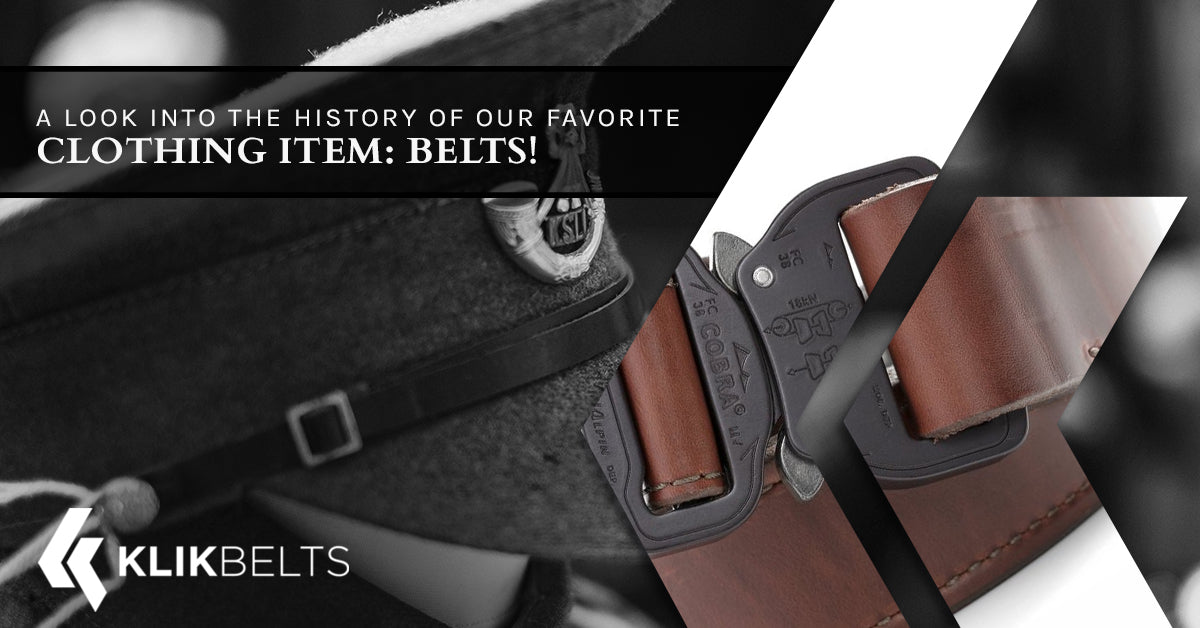
A Look Into The History Of Our Favorite Clothing Item: Belts!
Belts have reliably upheld people’s pants for countless years, acting as a practical finishing touch on an outfit and preventing countless people from having their pants getting pulled down in the name of an immature (but oh-so-hilarious) joke. Indeed, the history of belts goes back to sometime in the Bronze Age. There are signs of early belts throughout many different parts of the world, and though it would take thousands of years before the advent of Klik Belts to hit the market, you could say that we give nothing but respect to pant’s best friend.
An Ode To Our Early Belt Ancestors
In the next installment of our online belt blog, Klik Belts, your one-and-only source for adjustable belt buckles and aluminum buckle belts online, offers a mildly abridged history of belts. Keep reading below, and don’t forget to shop our selection of the world’s strongest and most comfortable belts. Let’s get started!
A (Somewhat) Brief Look At The History Of The Belt
Early Ages Of The Belt
The first leather belts — which, to no surprise, haven’t changed that much over the course of thousands of years — were used in the Bronze Age, sometime around 3000 BC to 1050 BC. These early belts weren’t what you’d traditionally think of as a leather belt, however. Advancements in leatherworking were to come hundreds of years later, and very early belts consisted of softened tree bark and gathered cloth pieces. They were, however, traditionally placed around the waist.
Belts Used For Self-Defense (Circa The Iliad)
During the time of the Trojan War, which occurred during 1200-1100 BC, soldiers at that time wore three different belts (as referenced in The Iliad): the zoster, a leather girdle with decorative stones; the aorter, a weapon that belt held a sword that was thrown over the chest (similar to a sheath); and a telamon, meaning a belt that was worn over the shoulder for any purpose (generally for holding some type of item).
Typically, these types of belts were thick enough to shield the wearer against being impaled by an arrow. At least, that’s what’s mentioned in The Iliad!
Early Leatherworking
While belt buckles and metal hooks were starting to be cast from bronze, and would later have a stronger, reinforced iron core, leatherworking itself also made some advancements. Leather eventually became a commodity that was valuable enough to trade for utilitarian purposes, as they were capable of carrying weaponry and other useful items.
Before leatherworking started to really progress, stiff pieces of hide would rot in the sun. The use of animal fats eventually brought enhanced flexibility to leather, however, and aldehyde, sourced from burned leaves, has used to tan the leather.
Into The 1900s
Hey, we said that this was an abridged history lesson, right? Belts being used as a fashion accessory waxed and waned throughout the 17th and 18th centuries, but made somewhat of a resurgence in the 1800s. Women would wear belts and sashes to complement their dresses, thereby helping to define their waist.
The flapper movement of the 1920s meant that a lot of women choose long dresses over pants with belts, but the decline of suspender popularity in the 1930s once again resulted in more folks wearing belts. Buckles, as well as belt loops, were virtually nonexistent up until the 1930s. Belts used to be sealed together with knots, or even glue in certain instances. We can’t imagine that using glue or tying your belt buckle in a knot would result in a strong belt buckle!
The 1950s And Beyond
Though there was a distinct supply shortage during the era of World War II in the 1940s, belts were once again able to hit the mainstream scene during the relative abundance of the 1950s and 1960s. More styles of belts hit the market, such as the cinch belt, wider women’s belts, metal belts, and belts with a large buckle as the focus.
Going into the 70s and 80s, belts saw some of the most interesting and “creative” designs to date — though it’s no secret that fashion really started to become more “bold” around this time period. The 90s saw the rise of the iconic studded belt, a rebellious look often donned by those in the punk, heavy metal, or grunge subcultures. Studded belts usually came with plastic or metal spikes.
The Innovation Of The Clickable Belt Buckle
While Klik Belts aren’t the only belt with a metal buckle that “clicks” in like a seat belt, we’re the only ones to make the world’s strongest belt. In 2014, Klik Belts was born, utilizing our standard 7075 aluminum alloy COBRA® buckle from our friends over at AustriAlpin. With solid brass release clips and 1 ½” nylon webbing, coupled with sleek, unisex styling, we were able to shake up the belt game in a way that no one else had.
Though the 7075 aluminum found in every single belt buckle we use has actually been in use since the era of World War II, we still use it to this day for one good reason — it’s still one of the single strongest and most lightweight metals available. Why fix what isn’t broken, right?
Shop The Strongest And Most Comfortable Belt Today!
Pay your respects to the history of belts by getting the latest and greatest in belt technology. Your pants deserve it, and you certainly owe it to yourself. Check out our men’s and women’s collections, or feel free to get in touch with us if you have any questions.


